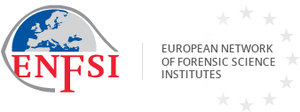European Network of Forensic Science Institutes
The European Network of Forensic Science Institutes (ENFSI) was founded in 1995 in order to facilitate dialogue among the forensic science practitioners of Europe, as well as improving the quality of forensic science delivery. In addition to quality, research, and education, different forensic disciplines address domain-relevant issues within expert working groups (EWGs) to the highest degree such that ENFSI is recognized as the monopoly organization for forensics science by the European Commission.
The number of member laboratories has increased since ENFSI's inception from 11 member laboratories in 1993 to 71 in 2019. The present membership comes from 38 countries geographically spread across Europe including Austria, Armenia, Azerbaijan, Belgium, Bulgaria, Croatia, Cyprus, Czech Republic, Denmark, Estonia, Finland, France, Georgia, Germany, Greece, Hungary, Ireland, Italy, Latvia, Lithuania, Former Yugoslav Republic of Macedonia, Malta, Montenegro, The Netherlands, Norway, Poland, Portugal, Romania, Russia, Serbia, Slovenia, Slovakia, Spain, Sweden, Switzerland, Turkey, Ukraine, and the United Kingdom.[1]
Non-European laboratories are also permitted to be involved in ENFSI as 'Associate' member laboratories under a specific Expert Working Group.[2]
History
Representatives from 11 governmental forensic laboratories in Western Europe attended a preliminary meeting in 1993 in Rijswijk, Netherlands. The official founding meeting occurred on October 20, 1995, in Rijswijk and was open to all European countries. A memorandum of understanding was signed which governed its operation, the first board was elected, and the logo was introduced. The first constitution for ENFSI was accepted by the membership in 1999, and the ENFSI website was created. A new constitution was later approved in 2004 when personal membership was discontinued in favour of institutional membership, and membership fees were enacted. The European Commission recognized ENFSI as the sole voice of the forensic science community in Europe in 2009 and since 2015, ENFSI has been regarded as a non-profit organization, at which time the decision was also made to move the secretariat from the Netherlands to Germany.[3]
Expert working groups
ENFSI has seventeen Expert Working Groups (EWGs) actively collaborating on furthering their respective disciplines:
- Animal, Plant and Soil Traces (APST)
- Digital Imaging (DIWG)
- DNA
- Documents (EDEWG)
- Drugs (DWG)
- Explosives (FINEX)
- Fingerprint (EFP-WG)
- Firearms/Gunshot residue (FAID/GSR)
- Fire and Explosions Investigation (FEIWG)
- Forensic Information Technology (FIT)
- Forensic Speech and Audio Analysis (FSAAWG)
- Handwriting (ENFHEX)
- Marks
- Paint & Glass (EPGWG)
- Road Accident Analysis (RAAEWG)
- Scene of Crime
- Textile and Hair (ETHG)
Projects and Activities
ENFSI collaborated with the French Institut National de Police Scientifique (INPS) in 2011 to establish a European database of ink dyes and stained banknotes.[4]
In 2015, ENFSI concluded a Memorandum Of Understanding (MoU) with Europol, the European Union’s law enforcement agency, which permits the "exchange of knowledge and expertise, underpinning the need for enhanced cooperation in the area of forensic science in the fight against crime."[5]
Honours
In 2018, the Distinguished Forensic Scientist Award was given to the first female recipient, Niamh Nic Daéid.[6]
External links
- ENFSI Official website
- ENFSI on Linkedin
- ENFSI's Email address: [email protected]
References
- ↑ "ENFSI: 71 members in 38 countries" (PDF). ENFSI - About ENFSI - Members. ENFSI. Retrieved 4 March 2020.
- ↑ ENFSI Framework for Expert Working Groups (PDF). May 30, 2019. p. 2. Retrieved 4 March 2020.
Section 5.2. Associate Member. An EWG may appoint Associate Members as representatives from other forensic institutes, universities or other institutions which are not member institutes of ENFSI.
- ↑ Kjeldsen, Terje; Neuteboom, Wim (2015). The History of ENFSI 1995-2015: 20 years of forensic cooperation in Europe (PDF). ENFSI. Retrieved 4 March 2020.
- ↑ "EURICPA Organises the First European Conference on Stained Banknotes, Held in Brussels". Business Wire. November 21, 2011. Retrieved March 3, 2020.
- ↑ "Europol and ENFSI intensify cooperation in forensic science". Europol. 10 March 2015. Retrieved 4 March 2020.
Üllar Lanno, Chairman of ENFSI says: "Our members already cooperate with Europol with a scene of crime and cyberspace evidence. This MoU is a logical step forward to strengthening our partnership and realizing a borderless European forensic science area, where both organizations can play an important role, through data and knowledge exchange."
- ↑ Jon Brady (September 18, 2018). "Dundee researcher Roy uses virtual reality to revolutionise crime investigations". Evening Telegraph. Retrieved March 3, 2020.
This article "European Network of Forensic Science Institutes" is from Wikipedia. The list of its authors can be seen in its historical. Articles taken from Draft Namespace on Wikipedia could be accessed on Wikipedia's Draft Namespace.
